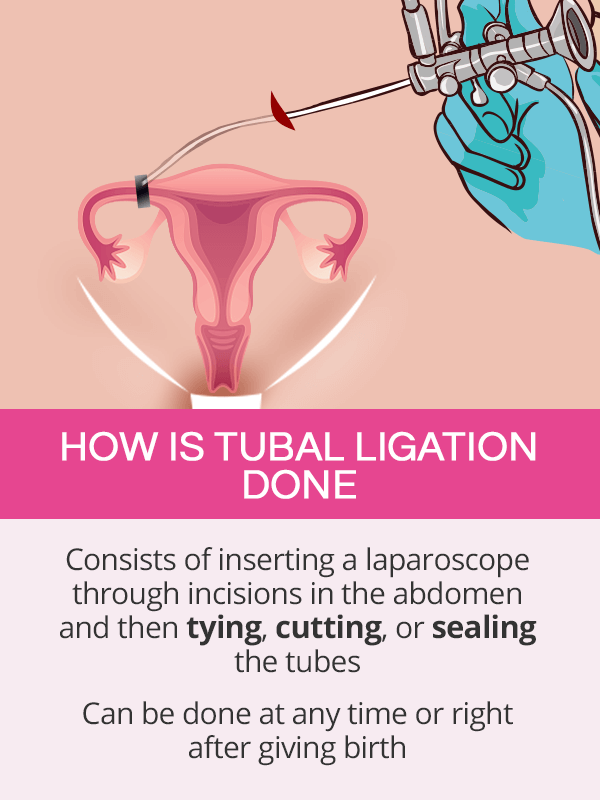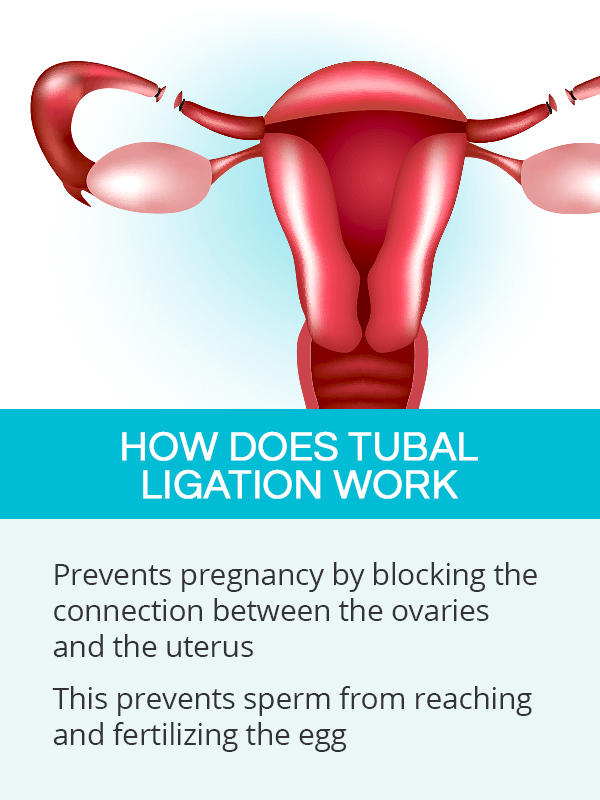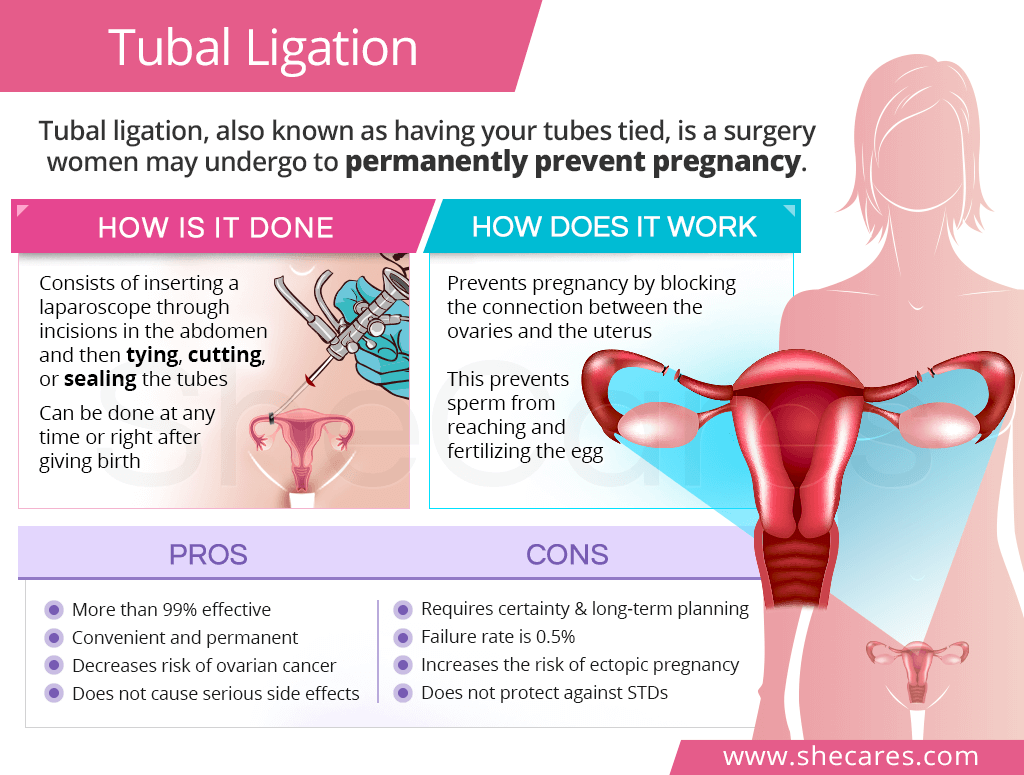What is Tubal Ligation?
Tubal ligation is a surgery aimed at closing a woman's fallopian tubes as a means of permanently preventing pregnancy. It is commonly referred to as tubal sterilization or – more colloquially - “having your tubes tied.”
Most commonly, tubal ligation is chosen by women who are certain they do not want to have children in the future.
However, the procedure can also be a valid option for women with a family history of ovarian cancer and want to lower their risk of developing it.
How is Tubal Ligation Done

Tubal ligation is most commonly an outpatient laparoscopic procedure, which takes about half an hour.1 It can also be done immediately after giving birth, both vaginally and through a C-section.
A woman will typically receive general anesthesia for the duration of surgery. Once small incisions are made in the abdomen, a laparoscope (a thin tube with a camera attached to it) will be inserted through them. The surgeon will then perform one of three techniques:
- Tying the tubes with clips or rings
- Cutting and tying the tubes
- Sealing the tubes with heat
Following tubal ligation, most women return home the same day, unless they have just given birth and need to stay in the hospital for longer. They should avoid lifting heavy objects for a few weeks or until cleared by their surgeon.
How Does Tubal Ligation Work

As aforementioned, the purpose of tubal ligation is preventing pregnancy. It is achieved by blocking the connection between the ovaries and the uterus at the level of the fallopian tubes. This prevents sperm from reaching and fertilizing the egg.
Can Tubal Ligation Be Reversed?
Yes, tubal ligation can sometimes be reversed.
However, it is important to understand that tubal ligation reversal is a major surgery that may not be successful for all women. This may depend on the technique used during tubal ligation and a woman's age.
The chances of getting pregnant after tubal ligation are 50-80%.2 Women who decide to get pregnant after having their tubes removed may consider in vitro fertilization (IVF).
Does Tubal Ligation Cause Menopause?
No, undergoing tubal ligation does not cause menopause.
During the procedure, only the fallopian tubes are affected, and the ovaries are left intact. A woman will continue having her periods until she naturally reaches menopause.
Pros and Cons of Tubal Ligation

For most women, tubal ligation proves to be a contraceptive method that comes with convenience and peace of mind. However, despite its numerous benefits, it involves important limitations that need to be considered.
Pros of Tubal Ligation
- Tubal ligation is more than 99% effective in preventing pregnancy.3
- Tubal ligation is a one-time procedure and a one-time cost.
- Studies have linked tubal ligation with a decreased risk of ovarian cancer.4
- It does not cause significant or serious side effects.
- It does not involve the use of synthetic hormones.
Cons of Tubal Ligation
- Being a permanent form of birth control, it requires thorough, long-term planning.
- Although rare, 1 in 200 women get pregnant after tubal ligation due to an improperly performed procedure or spontaneous tube regeneration.2
- Tubal ligation reversal is possible for some women, but does not guarantee subsequent pregnancy.
- There is a higher risk of ectopic pregnancy for women who do get pregnant after a tubal ligation.3
- It does not protect against sexually transmitted diseases (STDs).
Key Takeaways
Tubal ligation is a popular option among women who choose not to have children in the future, for personal or medical reasons. Also called having one's tubes tied, it is a safe and quick procedure consisting of inserting a laparoscope through the incisions in the abdomen and then tying, cutting, or sealing the fallopian tubes. It can be done at any time or right after giving birth. Tubal ligation is one of the most reliable birth control methods, with more than 99% of effectiveness. Tubal ligation can sometimes be reversed, although it is not always successful. It is key to keep in mind that about 1 in 200 women get pregnant after having their tubes tied. Those who do have a higher risk of ectopic pregnancy. Nevertheless, undergoing tubal ligation is a largely reliable contraceptive option for women who are certain about their reproductive future.
Sources
- American Pregnancy Association. (2016). Pregnancy after Tubal Ligation - Is It Possible? Retrieved December 3, 2020 from http://americanpregnancy.org/preventing-pregnancy/pregnancy-tubal-ligation
- Health Direct. (2020). Tubal Ligation. Retrieved December 3, 2020 from https://www.healthdirect.gov.au/tubal-ligation
- Medline Plus. (2020). Tubal ligation. Retrieved December 3, 2020 from https://medlineplus.gov/ency/article/002913.htm
- Planned Parenthood. (n.d.). Sterilization. Retrieved December 3, 2020 from https://www.plannedparenthood.org/learn/birth-control/sterilization
- StatPearls. (2020). Tubal Sterilization. Retrieved December 3, 2020 from https://www.ncbi.nlm.nih.gov/books/NBK470377/
Footnotes:
- Medline Plus. (2020). Tubal Ligation. Retrieved December 3, 2020 from https://medlineplus.gov/tuballigation.html
- Johns Hopkins Medicine. (n.d.). Tubal Ligation. Retrieved December 3, 2020 from https://www.hopkinsmedicine.org/health/treatment-tests-and-therapies/tubal-ligation
- Better Health Channel. (2019). Contraception - tuba ligation. Retrieved December 3, 2020 from https://www.betterhealth.vic.gov.au/health/healthyliving/contraception-female-sterilisation
- Mayo Clinic. (2018). Tubal ligation. Retrieved December 3, 2020 from https://www.mayoclinic.org/tests-procedures/tubal-ligation/about/pac-20388360
